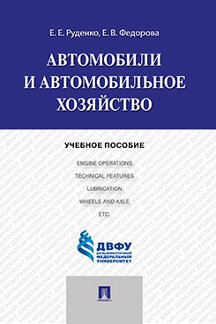|
|
ОглавлениеUNIT I. Automobile. Development of the Automobile. Automobile Industry UNIT II. Components of Automobile UNIT IV. Engine Operation. The Four-Stroke Cycle. The Two-Stroke Cycle Vocabulary. A. B. C. D. E. F. G. H. I, J, K. L. M. N. O. P, Q. R. S. T, U. V. W Для бесплатного чтения доступна только часть главы! Для чтения полной версии необходимо приобрести книгуUNIT I. AutomobileDevelopment of the AutomobileVocabulary: automobile – автомобиль carriage – повозка cylinder – цилиндр engine – двигатель features – особенности internal-combustion engine – двигатель внутреннего сгорания inventor – изобретатель lever – рычаг mass production – массовое производство rear wheel – заднее колесо self-propelled vehicle – самоходное транспортное средство speed – скорость to accelerate – ускорять to produce – производить to require – требовать well-known – известный The automobile has a long history. The French engineer Nicolas Joseph Cugnot built the first self-propelled vehicle (Paris, 1789), a heavy, three-wheeled, steam-driven carriage with a boiler that projected in front; its speed was 5 kph. In 1801 the English engineer Richard Trevithick also built a three-wheeled, steam-driven car; the engine drove the rear wheels. Development of the automobile was retarded for decades by over-regulation: speed was limited to 6.4 kph and until 1896 a person was required to walk in front of a self-propelled vehicle, carrying a red flag by day and a red lantern by night. The Stanley brothers of Massachusetts, the most well-known American manufacturers of steam-driven autos, produced their Stanley Steamers from 1897 until after World War I. The development of the automobile was accelerated by the introduction of the internal-combustion engine. Probably the first vehicle of this type was the three-wheeled car built in 1885 by the engineer Karl Benz in Germany. Another German engineer, Gottlieb Daimler, built an improved internal-combustion engine c.1885. The Panhard car, introduced in France by the Daimler company in 1894, had many features of the modern car. In the United States, internal-combustion cars of the horseless buggy type were manufactured in the 1890s by Charles Dmyea and J. Frank Duryea, Elwood Haynes, Henry Ford, Ransom E. Olds, and Alexander Winton. Many of the early engines had only one cylinder, with a chain-and-sprocket drive on wooden carriage wheels. The cars generally were open, accommodated two passengers, and were steered by a lever. The free growth of the automobile industry in the early 20th cent. was threatened by the American inventor George Selden’s patent, issued in 1895. Several early manufacturers licensed by Selden formed an association in 1903 and took over the patent in 1907. Henry Ford, the leader of a group of independent manufacturers who refused to acknowledge the patent, was engaged in litigation with Selden and the association from 1903 until 1911, when the U.S. Circuit Court of Appeals ruled that the patent, although valid, covered only the two-cycle engine; most cars, including Ford’s, used a four-cycle engine. The mass production of automobiles that followed, and the later creation of highways linking cities to suburbs and region to region, transformed American landscape and society. Внимание! Авторские права на книгу "Автомобили и автомобильное хозяйство. Учебное пособие" (Руденко Е.Е., Федорова Е.В.) охраняются законодательством! |
||||||||||||||||||||||











